In a rather uncertain world, there are some things we can be sure of. Caffeine is life. Change is inevitable. And reviews are a really big deal.
Reviews, which were once a “nice to have” are now a must-have, regardless of whether a consumer is looking for a new couch for their living room, a new beach read for an upcoming vacation, or even a new sitter to watch their kids while they enjoy a night out.
But – digging deeper – what exactly are they looking for when they browse reviews on a product page?
A key insight from our recent research is that consumers consider a bunch of different factors when reading reviews – and deciding whether to purchase the product in question. But there are two factors that rise to the top: review volume and review recency.
Review Volume and Recency Defined – and Why These Factors Matter
Before we dive into a discussion about when review volume and recency are particularly important, let’s get aligned on what these terms mean – and why they’re important.
What is Review Volume?
As you might have guessed, review volume is a term used to describe the number of reviews available for a given product. Let’s say a consumer is shopping for mascara. They come across one product with three reviews, and another with over 25,000 reviews.
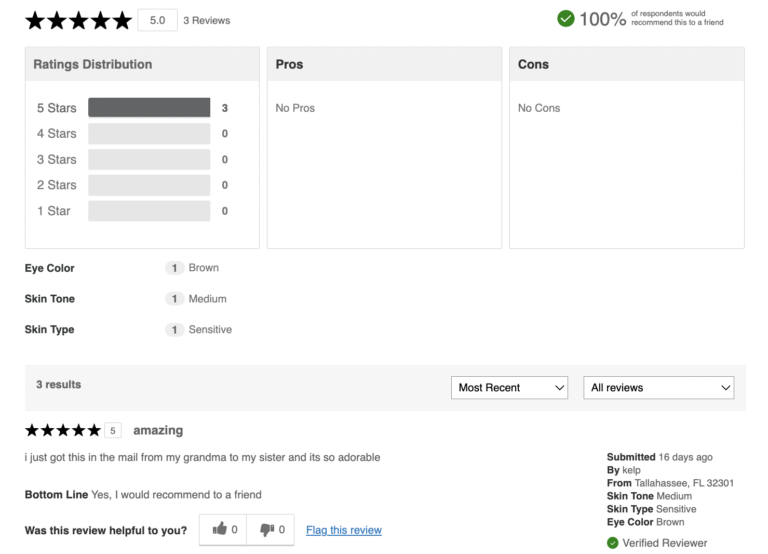
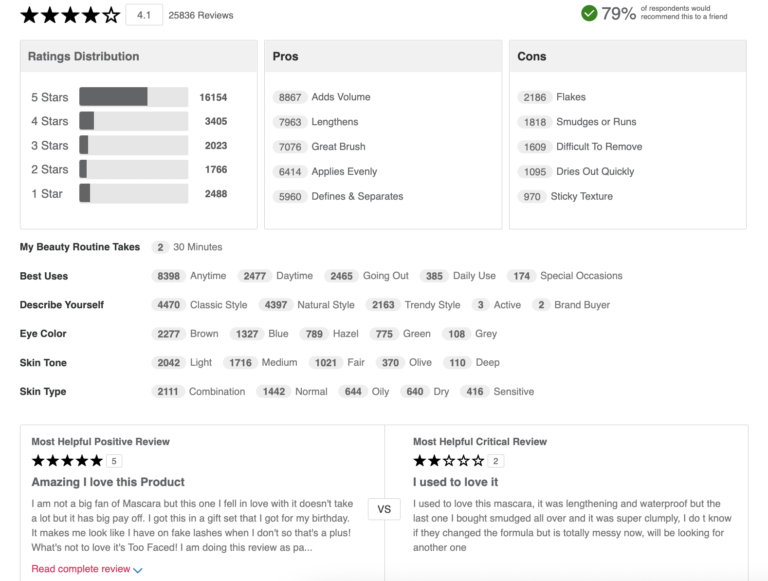
Do they notice the difference in quantity? And do they care?
Absolutely! Our recent research found that a whopping 79% of consumers consider volume regularly or always when reading reviews.
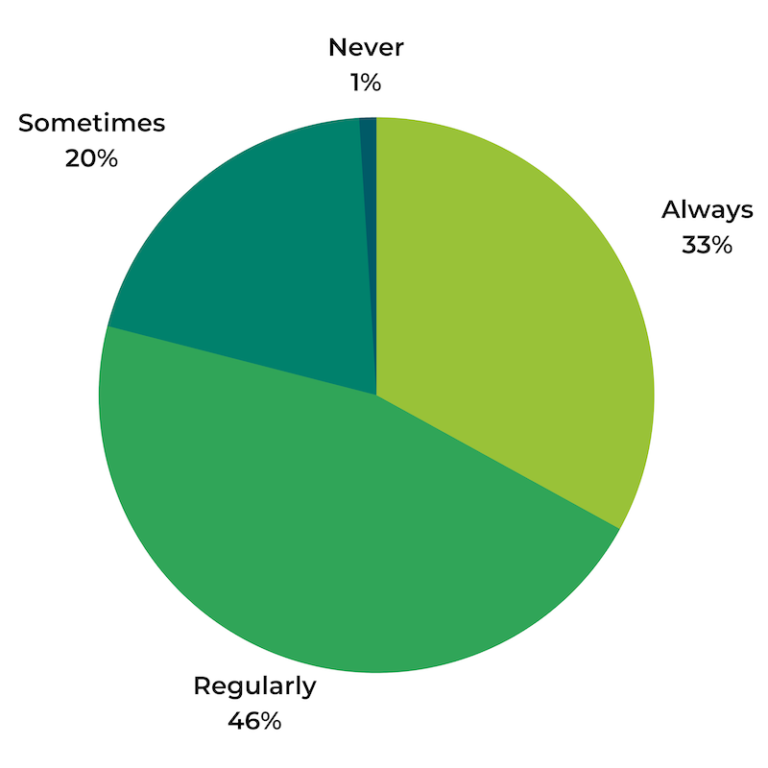
Our own analysis of consumer activity across more than 1.5MM online product pages from more than 1,200 brand and retail sites further proves that more reviews = more sales.
If you’re interested in digging deeper into the importance of review volume (and are curious how many reviews you need for your products), check out this recent post.
What is Review Recency?
Review recency is (yup, you guessed it) how recently a review was written.
Do consumers notice that one of these reviews was written 3 years ago, while the other is from last week?
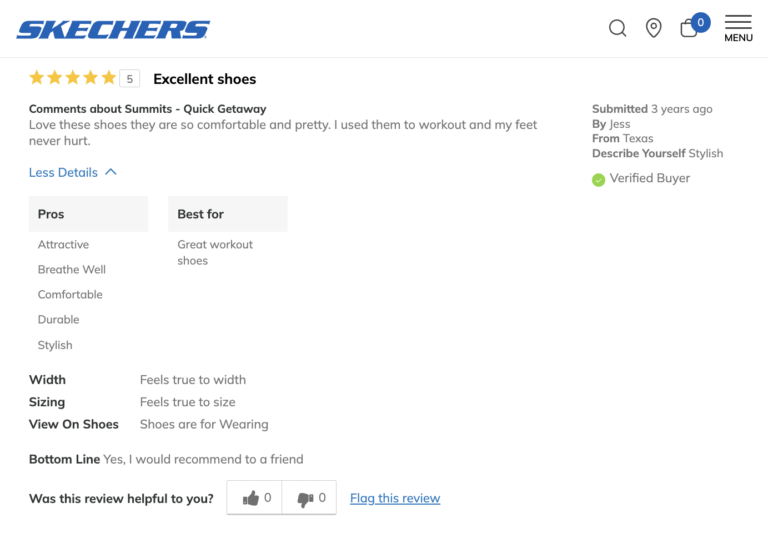
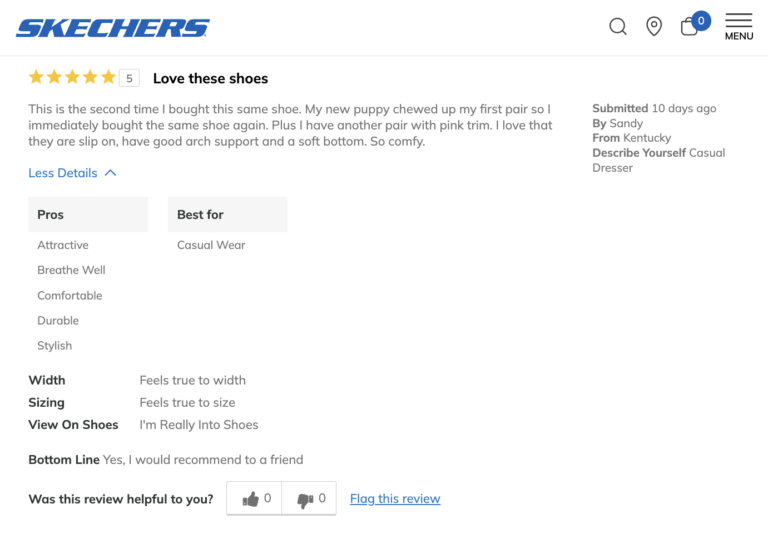
Yes! Per our research, 88% of consumers consider when a given review was written.
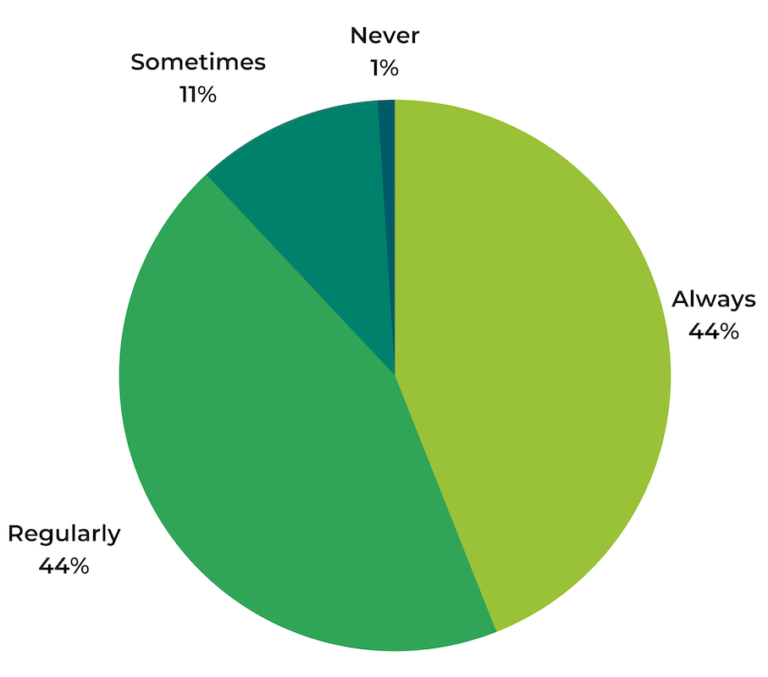
In fact, recency actually outweighs volume for many shoppers. 64% indicate they’re more likely to buy a product with fewer, more recent reviews than one with a high volume of reviews that were published 3+ months ago.
Now that we’ve defined volume and recency – and why brands and retailers should care – let’s explore when these factors are most important.
When Review Volume Matters Most
We’ve established that consumers pay attention to the volume of reviews for a given product. And, there are three circumstances when review volume is especially important to shoppers.
1. When They’re Purchasing New or Unknown Products or Brands
There are certain products you probably buy time and again, without giving it much thought. Maybe it’s dog food or skincare products or items on your grocery list. You’re not taking chances when you buy these products; you’ve used them in the past and know exactly what to expect.
But then there are those times when you feel like branching out and trying a new (or new to you) brand or product. There is risk involved here, because you don’t have any experience with the product. You could get it and end up hating it.
What helps shoppers overcome the risk of purchasing an unknown product? Reading a bunch of reviews. 71% indicate review volume is more important when considering a new product or brand. This number is especially high – 84% – for Gen Z’ers.
So make it a priority to boost your volume of reviews – especially if you’re releasing new products or are a relatively new brand to the market.
2. When They’re Purchasing Products in Certain Categories
Let’s be clear: review volume matters for all product types. But, there’s also no denying that volume is especially important when consumers are shopping for products within certain categories. Four categories, in particular, rise to the top.
Consumer electronics and appliances
80% of consumers consider review volume when purchasing these types of products. And this totally makes sense. Products in these categories are typically higher priced, which (as we’ll explore more in a bit) presents risk. Reading a high volume of reviews can help shoppers overcome that risk. In fact, there’s a 174.3% lift in conversion among those exposed to 5,000+ reviews for electronics and appliances, when compared to those exposed to no reviews.
Health and beauty
There are products that work largely the same – regardless of who purchases them – for example, a vacuum cleaner. Then, there are products like health and beauty items that are highly personal; they work differently for different kinds of people. For example, a concealer might work well for someone with combination skin – but not so great for someone with dry skin.
Review volume is super important for those shopping for health and beauty products; 71% of consumers consider volume when purchasing products in this category. And the more reviews, the better. There’s a 367.3% lift in conversion among health and beauty shoppers exposed to 5,000+ reviews, when compared to those exposed to no reviews.
Why? Most likely, because shoppers exposed to a ton of reviews are better able to find content that’s most relevant to their needs and use cases. And this gives them the confidence to purchase.
Clothes, shoes, and accessories
This is another example of a product category that’s highly personal. For example, a dress is going to fit and look different depending on a person’s height and body type.
63% of shoppers consider review volume for products in this category. Again, this is likely because those shopping for these products want to find a high volume of reviews so they can then narrow down to find content submitted by others like them. And displaying a high volume of content for products in this category pays off. Our analysis found that there’s 179.7% lift in conversion among clothing, shoe, and accessory shoppers exposed to 5,000 or more reviews.
Home improvement, decor, and furniture
Consumers’ homes reflect their unique personalities. And many spend time researching decor, furniture, and other items that’ll work best for their spaces. They depend on reviews to find the right items, and they pay attention to the quantity of reviews. 57% of consumers consider review volume when shopping for products in this category.
Similar to other categories, a high volume of reviews helps those shopping for home improvement, decor, and furniture to sort, filter, and search to hone in on content that was submitted by those with similar spaces, tastes, and needs. And the sweet spot seems to lie between 501 and 1,000 reviews. Those exposed to between 501 and 1,000 reviews convert at a rate that’s 154.9% higher than those exposed to no reviews.
Sure, review volume is particularly important for the four categories we explored above. But, it’s important to remember that a good portion of shoppers pay attention to review quantity for many categories, as outlined below.
Prioritize collecting a high volume of reviews for the categories for which it matters most. But, the ultimate goal should be to have lots of reviews across all product categories.
3. When They’re Purchasing Certain Types of Products
The value shoppers place on review recency also varies by product type. And there are two types of products for which volume is especially important.
High price point or luxury products
73% of shoppers say that volume is important when they’re considering an expensive or luxury product. And for good reason! If you’re about to sink a lot of money into a purchase, you probably want to know it’ll be a good fit for your needs. Reading a lot of reviews can boost a shopper’s confidence in their purchase decision.
New arrivals
As we mentioned before, there’s risk involved with purchasing a new product. Reading a lot of reviews can help shoppers overcome that risk. So it’s probably not surprising that 67% of consumers say they consider review volume when purchasing new arrivals. Prior to launching a new product, consider doing a product sampling campaign. That way, when you officially launch the product, there will already be plenty of reviews in place.
Other product types
Sure, review volume is especially important for high price-point and new products. But as you can see in the chart below, a good portion of shoppers also consider volume for items with a high purchase frequency, items that have been around for a long time, and non-season specific items. So while it certainly makes sense to make it a priority to collect a high volume of reviews for expensive items and new arrivals, the end goal should be to have a lot of reviews across all product types.
When Review Recency Matters Most
We know shoppers pay particularly close attention to review volume when they’re buying new (to them) products, as well as when they’re shopping for specific categories and types of products. But when does recency matter most?
By and large, recency matters in the same circumstances in which volume matters – but it matters even more. Let’s explore two of those instances.
1. When They’re Considering a New (to them) Product
Review volume is particularly important when consumers are considering a new (or new to them) product or brand. As it turns out, this is also a circumstance when review recency is especially important. 86% of shoppers say that review recency is more important when considering a product or brand they haven’t purchased before.
I can’t stress this enough: it is so important to generate a steady volume of fresh reviews – especially if you’re a newer brand or are releasing new products. That way, consumers (especially those who haven’t shopped with you before) can always find lots of fresh content to boost their confidence.
2. When They’re Purchasing Certain Categories of Products
Remember how we said review volume is particularly important when shoppers are purchasing products within certain categories? Namely, consumer electronics and appliances, health and beauty, apparel and shoes, home improvement and decor?
Well, recency is of the utmost importance for these exact same categories.
Take a look at the chart below and you’ll see that the categories for which recency matters most are ranked in the exact same order as the categories for which volume matters most. However, you’ll probably also notice that in every category, recency actually matters more than volume. And in some cases, it matters A LOT more. Take, for example, grocery products. While 37% of shoppers say volume matters in this category, over twice that amount – 78% indicate recency is important.
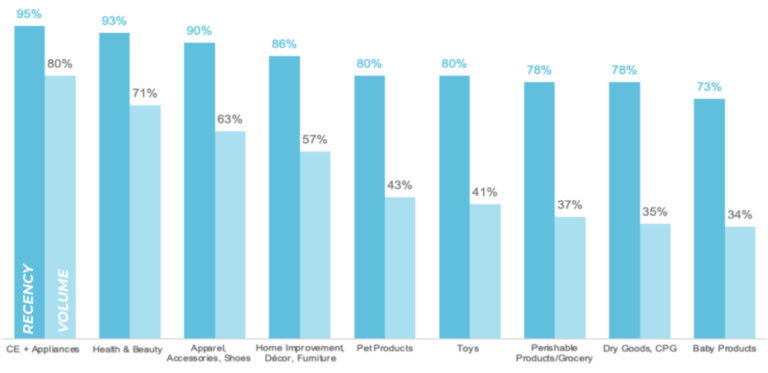
So while recency is especially important for consumer electronics and appliances, health and beauty, apparel, accessories and shoes, and home improvement decor, and furniture, the reality is, it’s super important across every single category in the list.
If you sell any of these product types, you’ve got to make it a priority to generate a steady stream of reviews so shoppers can always find recent content. Otherwise, you risk losing them to a brand with fresher content.
It’s Time to Prioritize Review Volume and Recency
Consumers consider many factors when reading reviews. But volume and recency rise to the top.
Review volume and recency are particularly important in certain circumstances, including when shoppers are considering new (to them) products and purchasing items in certain categories. So be sure to prioritize these types of products.
But make no mistake: review volume and recency are key factors across all product categories. So the end goal should be a high volume of recent reviews across your entire product catalog. The good news is, by generating a steady stream of reviews, you can achieve both your volume and recency goals. By doing so, you’ll better meet shopper expectations – and grow your sales.



